Why New York's Skyscrapers Keep Changing Shape
- Youtube Views 4,431,417 VIDEO VIEWS
Video presented and narrated by Fred Mills. This video contains paid promotion for Bluebeam.
IT’S SAID that you can tell a lot about a city by its tallest building. In New York, that was once the Chrysler Building: capitalism colliding with art and hubris to reign supreme over the skyline.
The title of the city’s tallest building has of course changed hands many times since, but the Chrysler has become a landmark in the one place above all others that’s synonymous with the skyscraper. Now, it’s set to be covered up by a new generation of glass-covered office towers.
Manhattan wouldn’t be the place it is today without the skyscraper. When it was first formed millions of years ago it’s geographic size wasn’t that notable and if it had stayed a small low-rise island it probably wouldn’t have amounted to much.
But these remarkable structures have let it continuously increase its area to welcome the millions of people and businesses who want a slice of the action. It’s skyscrapers that made New York.

Above: Manhattan's skyscrapers have greatly increased the island's size.
These awe-inspiring buildings have risen through every chapter of this city’s story – each a distinct product of the context and forces in play at the time, each coming to influence and shape the era that followed.
We saw it in the extravagance of the 1920s, then in the slicked back modernism of the 1960s. Skyscrapers personified the excess of the 1980s, but were then in an existential crisis after 9/11 when few knew what a skyscraper should be anymore – and they’re coming to represent some of the city’s biggest challenges once again in the 2020s.
What happens in New York is reflected in its skyscrapers. They stand both as monuments to its past and silent influencers of its future. This city is so much more than just the home of the skyscraper – it was made by them.
The 1920s - The Extravagant Skyscraper
It was Joseph Campbell who famously said that you can tell a lot about a city and what drives it by its tallest building. In medieval times, it was often the spire of a cathedral. In 18th century towns it was the political palace – and in 1920s New York it was the office building.
The American dream embodied by steel and sheer grit, the skyscraper was capitalism incarnate. The roaring twenties was a decade defined by excess and wealth; one which marked the transition of power from London to New York as the world’s metropolis. All of this gave rise to the Chrysler Building – a shining beacon that announced the city’s arrival and America’s wild success.
“I am Midwestern by birth, but I always knew I was really from New York." Carol Willis, an architectural historian and the founder of New York’s Skyscraper Museum, explained to us.
“Skyscrapers in New York and everywhere are really commercial architecture, they are buildings constructed to make money.”
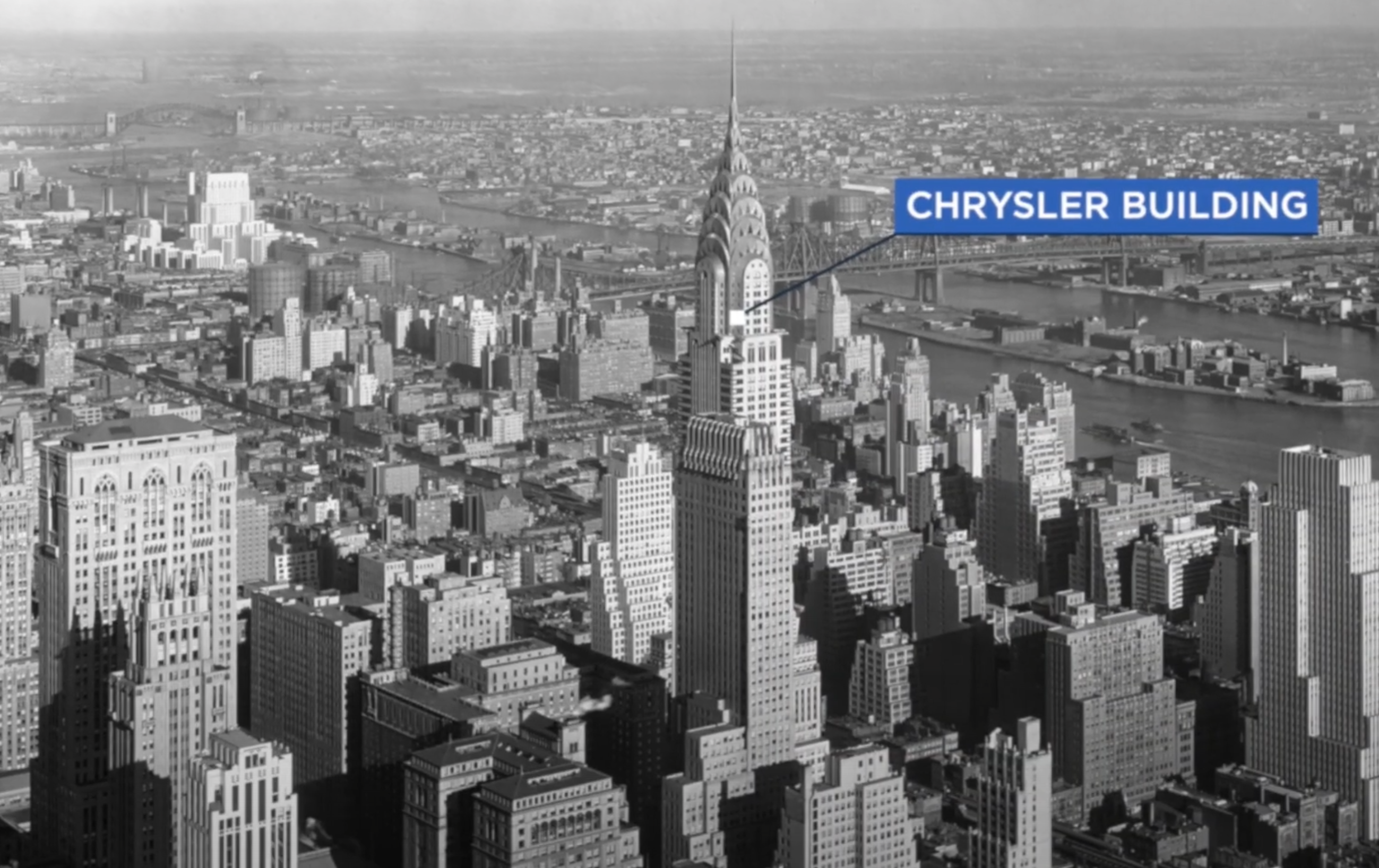
Above: The Chrysler Building was the tallest in the world when completed in 1930.
The Chrysler Building’s existence was fuelled by the fierce rivalry of two former business partners – architects Craig Severance and William Van Alen.
Severance was hired to design the Manhattan Co. Building – now known as 40 Wall Street - while Van Alen was asked to design the Chrysler Building. Both were vying to build the world’s tallest skyscraper and both would do pretty much anything to make it happen.
As the planning and construction of each skyscraper took place, the designers from either side would steal or leak plans of the buildings. The Manhattan Co. Building began adding more and more floors, pushing the limits of what its foundations could handle in a desperate attempt to best the Chrysler – and it seemed to work. The building completed in 1930 and was the tallest in the world… for about a month.
Van Alen had ingeniously constructed a secret spire hidden inside the crown of the Chrysler Building. Once the Manhattan Co. Building was finished the spire was pushed up through the roof into place, dramatically beating the other tower by 36 metres.
But when the Chrysler Building first appeared on the skyline many thought it was an eyesore – and yet, today it’s held up as one of the world’s greatest examples of art deco architecture. It’s an undeniably iconic landmark; one of the emblems of New York.
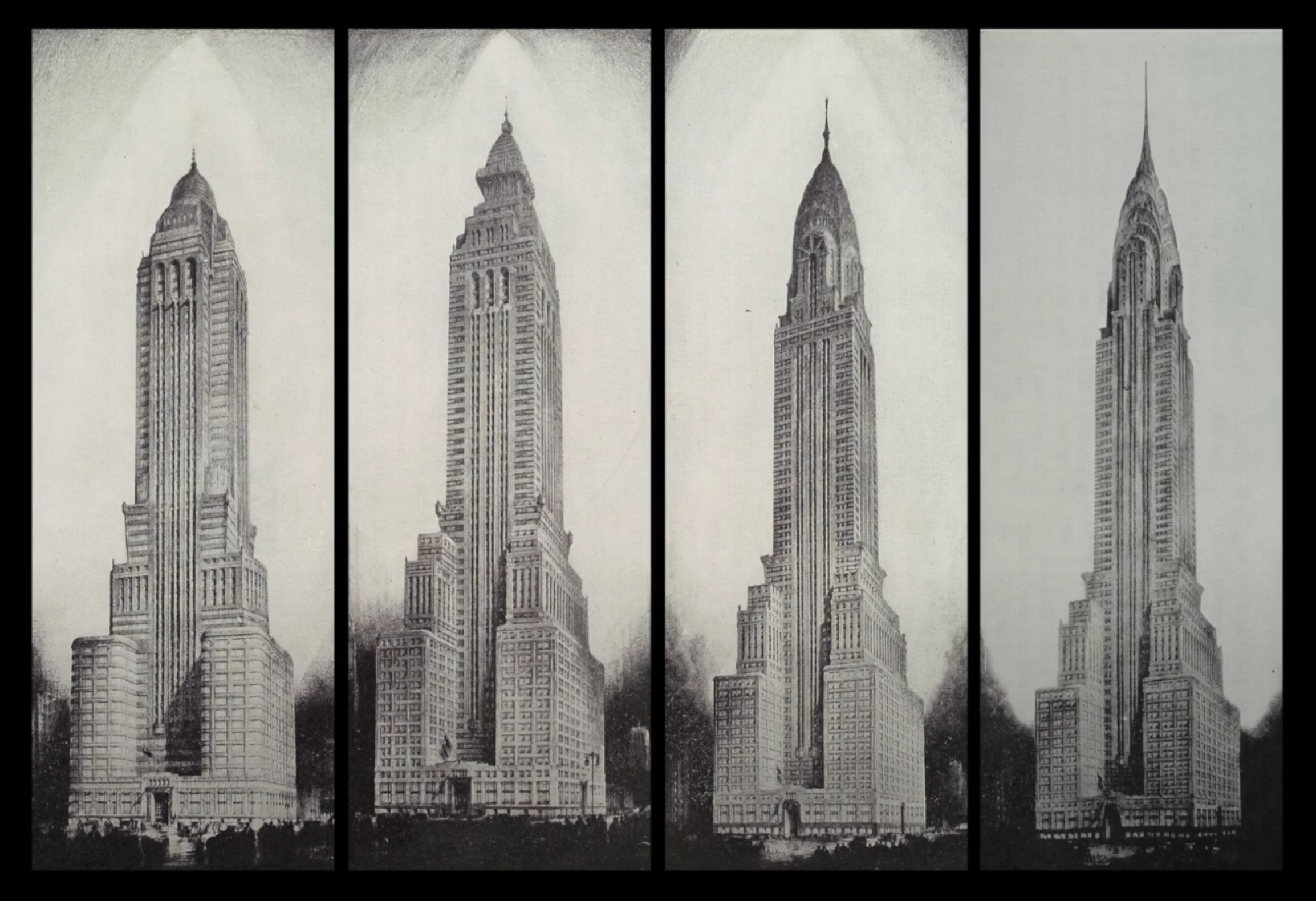
Above: Several design iterations of the Chrysler Building. Image courtesy of The New York Public Library.
“Everybody loves the Chrysler Building, it's such a wacky skyscraper, everything about it is an expression of the moment,” Willis said. “Recognisability, iconicity is something that has value in itself. When you say, you know, I work in the Chrysler Building, people know where you work.”
Walter Chrysler had wanted his skyscraper to represent opulence and luxury – but that didn’t go over well as the roaring twenties came to a screeching halt with the crash of the New York Stock Exchange and the onset of the Great Depression.
The city where this worldwide economic crisis began had at the same time built a 319-metre monument to capitalism. Unemployment rates were at their peak. Nearly a third of New York City's population was out of work. The extravagance of the 1920s was over.
Despite all the effort that had gone into making it the world’s tallest skyscraper, the Chrysler Building only held the title eleven months until the Empire State Building completed – astonishingly quickly – later in 1930.
Then the Great Depression and Second World War conspired to create a forty year period without any record-breaking skyscrapers in New York – the city’s focus was elsewhere, and that chapter of its history is recorded in a period of absent high rises.
When the skyscraper finally made a comeback things had to be seriously rethought.
The 1960s - The Modern Skyscraper
By the 1960s, New York was a different city. There were protests, strikes and violence. It was a time of radical change and unrest. It was a time for something new. Ornamentalism and detail were no longer right for buildings. It was all about simplicity and function now.
In an attempt to revitalise the then-struggling Lower Manhattan, Japanese-American architect Minoru Yamasaki was selected to design the World Trade Center in 1962.
He put forward an idea for two enormous twin towers, a pair of grey monoliths that were an almost extreme iteration of modernism. They had sleek straight lines, were aggressively vertical and had none of the step-backs or details of the city’s art deco skyscrapers. These were buildings born out of a very different New York.
Yamasaki’s fear of heights meant that the towers had relatively narrow windows, just 45 centimetres wide. They only covered 30 percent of each building, making them look like solid metal slabs from a distance.
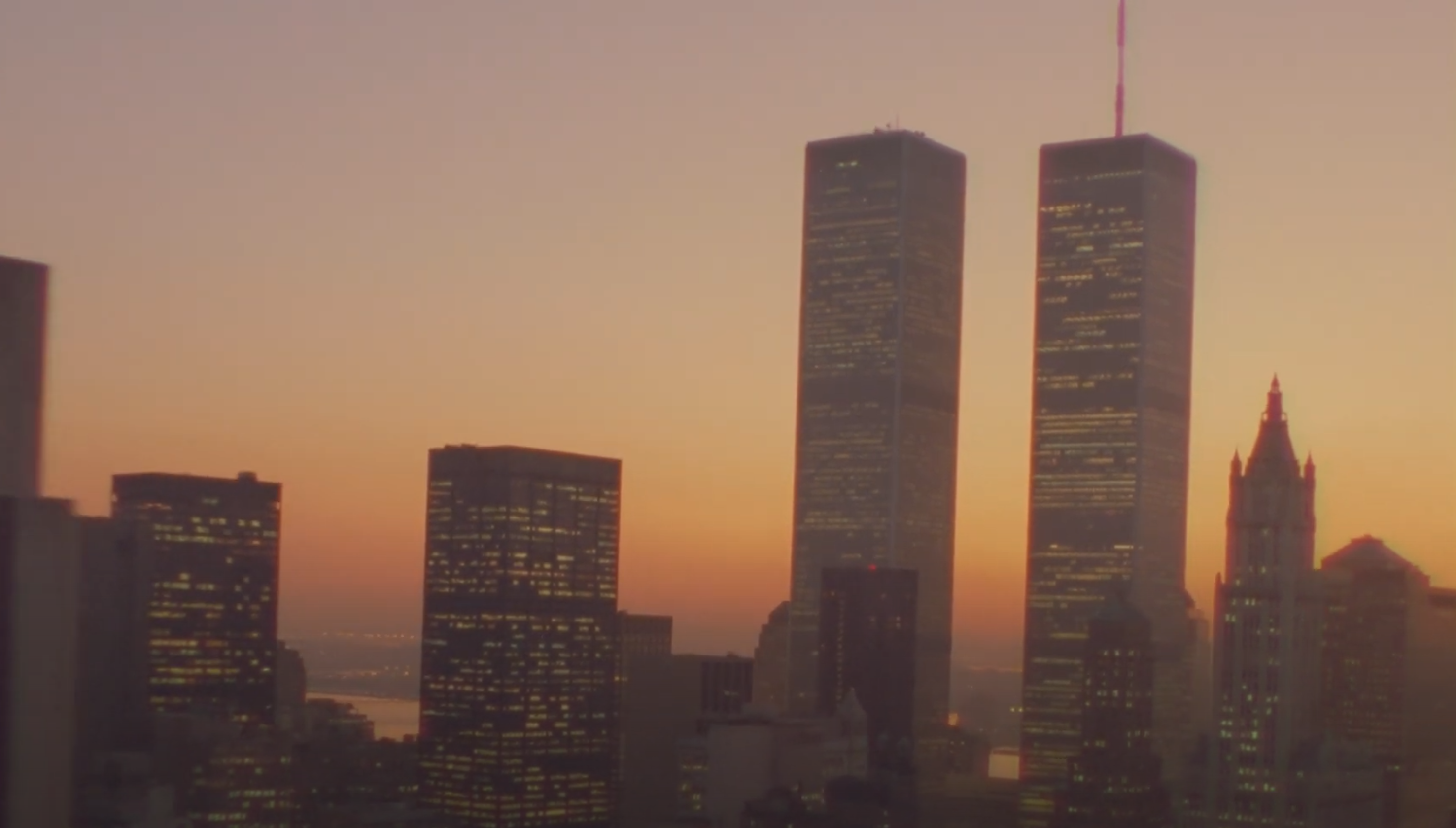
Above: The twin towers of the World Trade Center.
At the time it wasn’t economically feasible to build a skyscraper more than 80 storeys tall because of the space that its elevator shafts would take up on the floorplate. The higher you build, the more people you have living or working up the building and the more elevators you need – particularly in structures like these that don’t taper and have a huge floorplate, even at their summits. That all means more elevator banks, eating-up lettable floor space, and elevators don’t pay rent.
To get around this, Yamasaki designed sky lobbies on the 44th and 78th floors of each tower that would break-up the elevator journey. Crucially, that meant that different elevators could use the same shaft and reduced the overall number of shafts needed on the floorplate. It enabled the buildings to rise 110 storeys above the city – but also created a mini-commute for anyone with an office above the sky lobbies.
That wasn’t all. Structural engineering also had to advance to make these towers possible. The support columns for the towers were both at the central core, like a traditional skyscraper, and around the outside of the buildings. This essentially made each tower sort of like a box within a box, joined by horizontal trusses at each level. This meant there were no support columns within the actual floorplate, allowing for vast open office space.
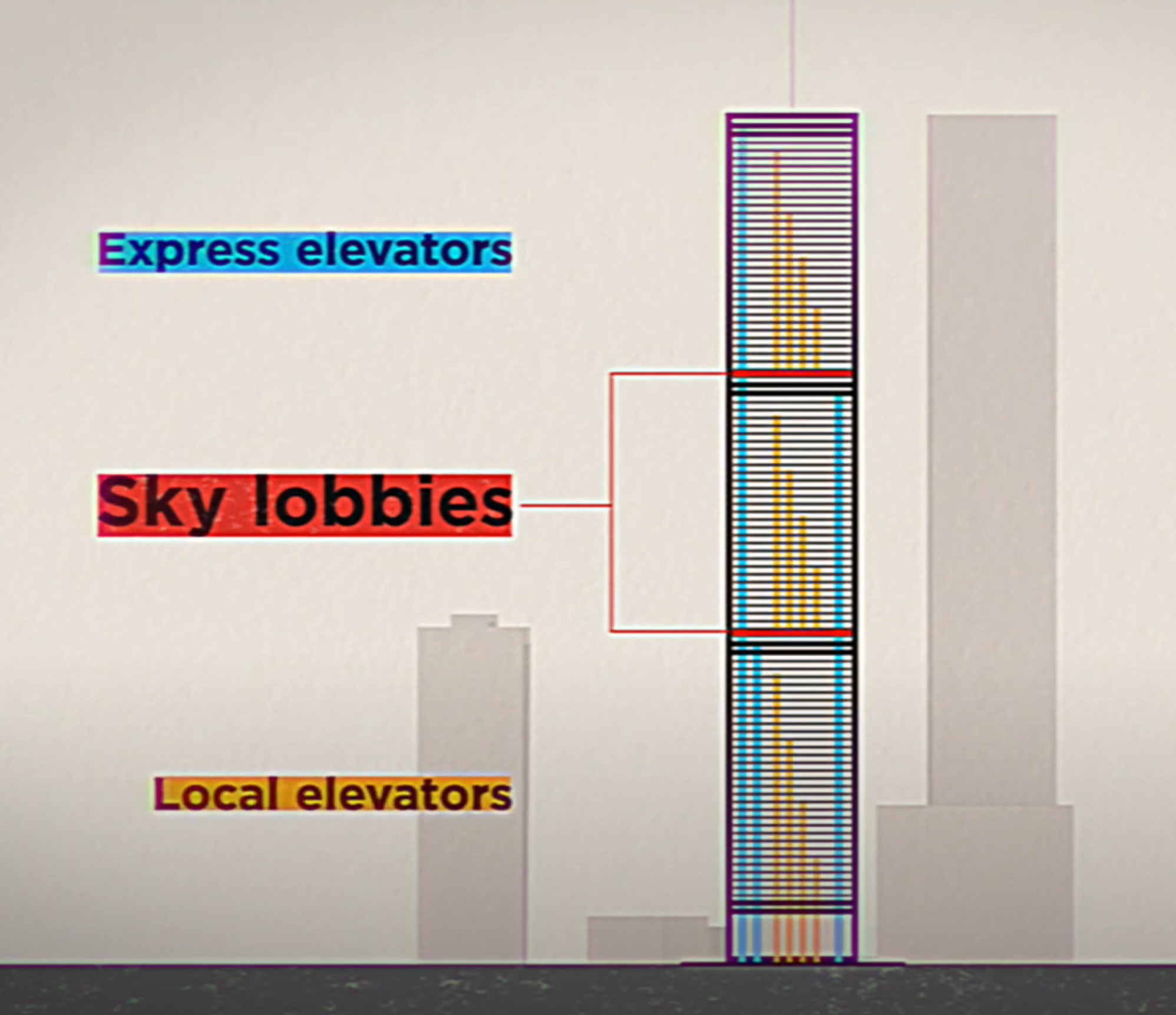
Above: The elevator system of the twin towers.
The towers finally opened their doors in 1973 to a public that had grown weary of them. The project cost the equivalent of USD $4.5B in today’s money – and had reportedly come at the expense of public transportation facilities. Some residents of Lower Manhattan were still angry at having to be relocated and critics said the buildings looked like giant filing cabinets or the boxes that the Empire State and Chrysler Buildings were delivered in.
But over the next decade they steadily became embraced as American icons – helped by films like King Kong, Superman and Manhattan, as well Philippe Petit’s heart-stopping tightrope walk between them in 1974. The Twin Towers became synonymous with the city itself.
The 1980s - The Glitzy Skyscraper
Big hair. Big ideas. Big buildings. The 1980s were about risk, excess, and glitz. It was a time when subtly was thrown out the window. If you were going to do something you had to be bold. Architecture was swinging away from the restrained clean lines of the 60s to something more extravagant. This was an era of experimentation, of clashing styles and ideas that wouldn’t ordinarily work together. New York was an altogether different beast in the 1980s too.
The Wall Street boom and falling unemployment spurred on the real estate market, though at the same time the city was experiencing record crime and soaring murder rates. This was a place of contradictions, of division, of glamour alongside poverty and violence but of extreme wealth and opportunity too.
Rising from all of it was a new skyscraper on Fifth Avenue that would kind of come to embody the ethos of the era. Enter Trump Tower.
At 202-metres it was the tallest all-glass structure in the city. Wrapped in bronze with interiors made of pink white-veined marble, mirrors and brass, the building is unmistakably '80s. It contains some of New York’s most prestigious residential, commercial and retail spaces – as well as an 18-metre high waterfall and a rumoured gold toilet. Some may call it gaudy, others call it pure luxury – and that may be precisely the point.
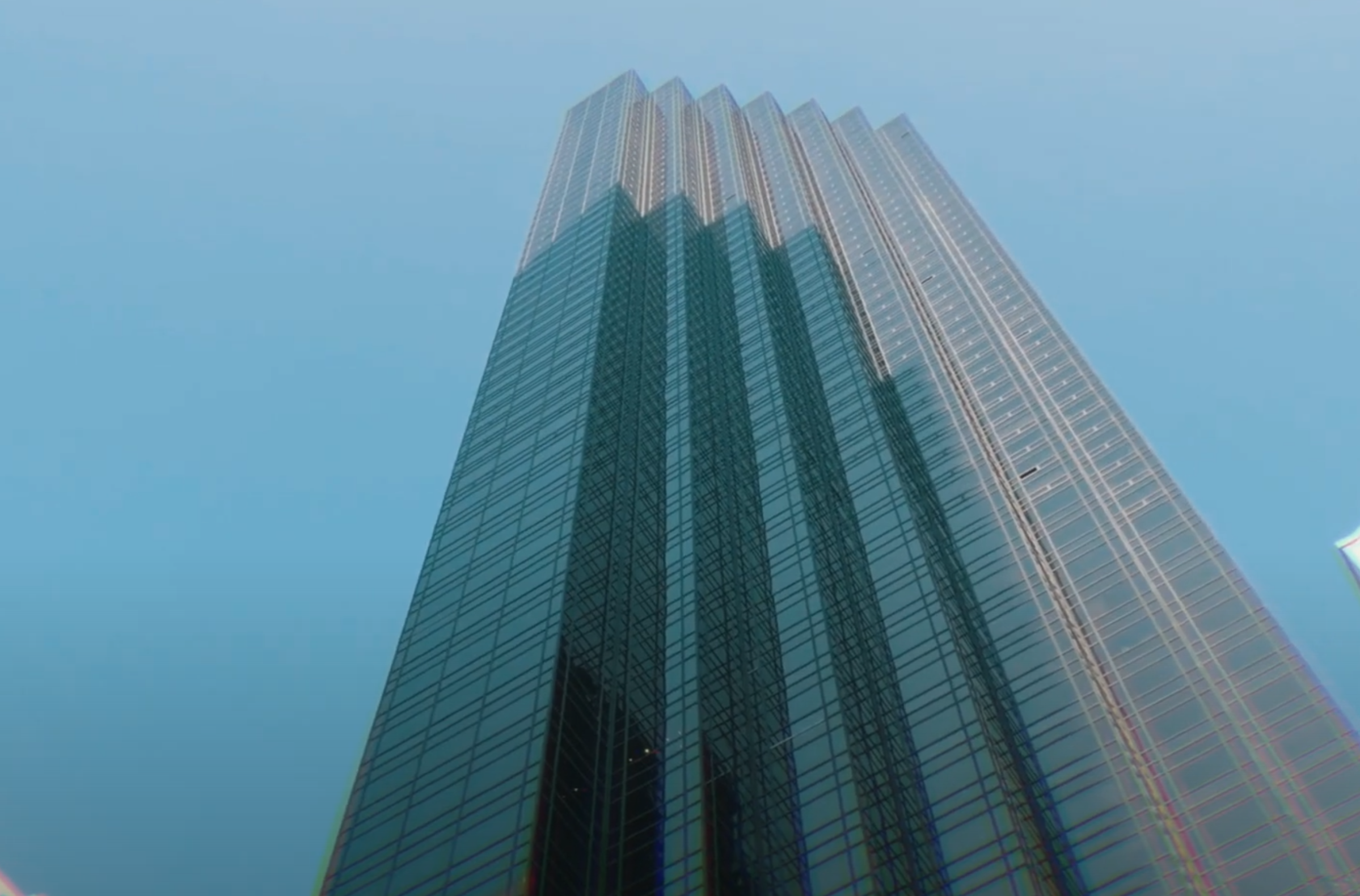
Above: Trump Tower's golden facade is unmistakably from the1980s.
To make way for Trump Tower, something of the old era had to be sacrificed, and the Bonwit Teller store took the hit.
Opened in 1929, the iconic 12-storey limestone and granite emporium was designed by Warren and Wetmore, the same architects as Grand Central. Donald Trump had his eyes on the site for years and when he acquired it in 1979, planned to demolish the building to make way for his own skyscraper. He hired architect Der Scutt who later told New York Magazine of Trump’s vision for the site: “it has to flash to be good.”
Preservationists wanted to save a pair of four-metre Art Deco sculptures, and a large nickel-plated grill over the store’s entrance. Both were promised to the Metropolitan Museum of Art, but were ultimately destroyed when the effort to preserve them was found to be causing construction delays. And it wasn’t the only controversy surrounding the building of this particular skyscraper.
In many ways Trump Tower embodies the runaway ambitions of this time. The 1980s were the era of Reaganomics, real estate booms, and stock market highs and lows. Capitalism, growth and success – no matter the cost.
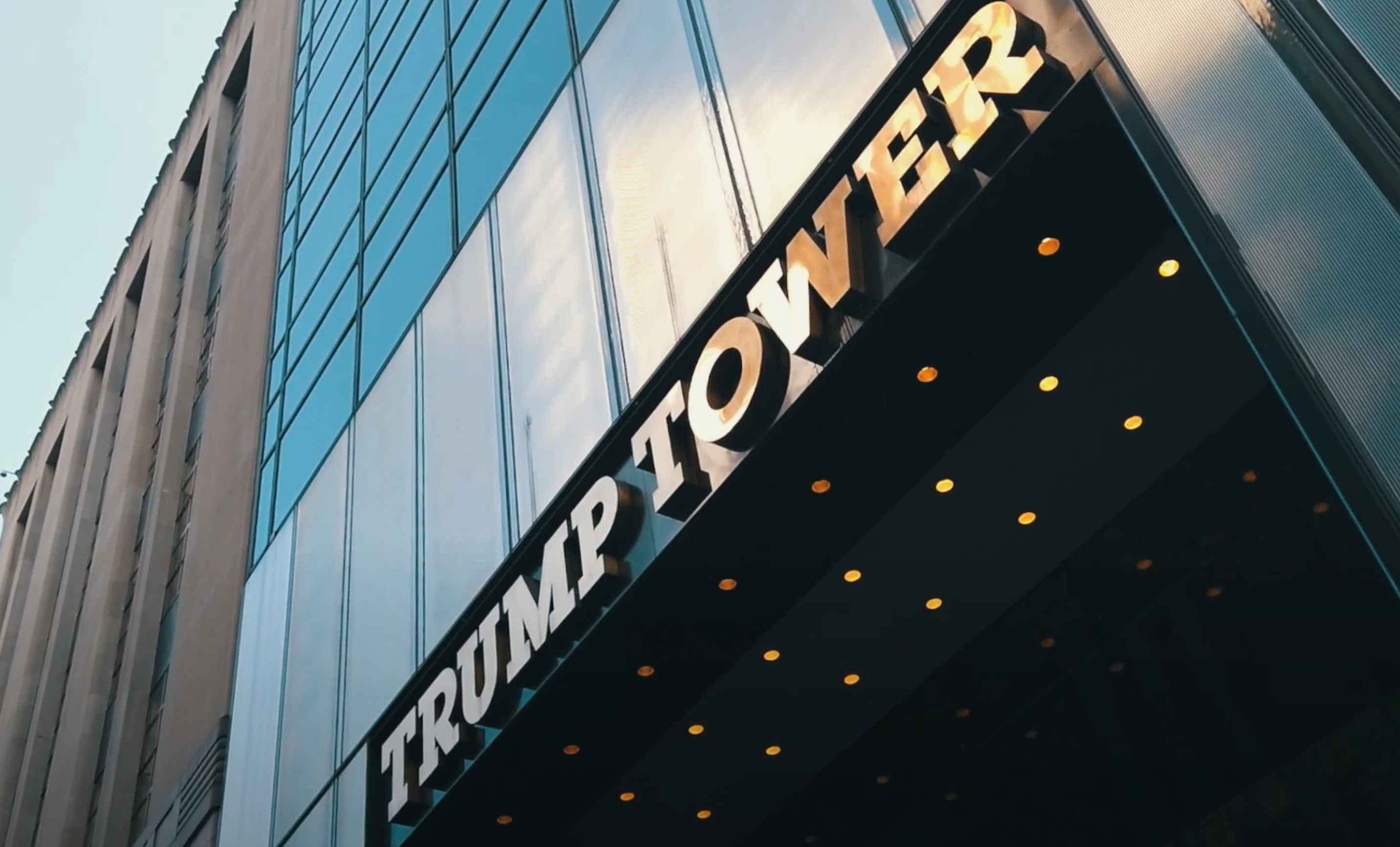
Above: Trump Tower has since become a place of protest.
In later years the tower has taken on new meaning, both as a place for protestors against and supporters of the former president. It’s perhaps even more divisive now than when it was first constructed, and what was once a landmark of decadence is now a symbol of division.
What a building represents, what it means as a symbol can change over the years. Or even in a single day.
The 2000s - The Existential Skyscraper
New York and its tall buildings were thrown into an identity crisis post-9/11. Did the world even want skyscrapers anymore? For a time, at the start of the 2000s, no one really knew the answer to that question.
Some said American cities should stop building skyscrapers altogether, fearing they’d create a magnet for future terrorism. Architect David Childs even told the New Yorker that many of his clients would not want to build such visible symbols, such iconic and tall buildings ever again.
One of the very few prominent skyscrapers to actually be built during this era was the Hearst Tower, rising a relatively modest 182-metres above the city. While the rest of the world was trying to figure out the future of high rises, Foster + Partners set about completing one from the past.
The firm made a conscious and active choice to push forward with construction despite the post-9/11 climate. They’d successfully combined modern architecture with the past before – both at the British Museum and the Reichstag. Now they were taking that technique to new heights.
Constructing a vertical extension on top of the existing Hearst Tower was moderately easier than it would have been with most other buildings. The historic structure was intended to support at least seven additional storeys, with some accounts putting that as high as 20. It also had six elevator shafts, double or triple the normal number for a place that size.
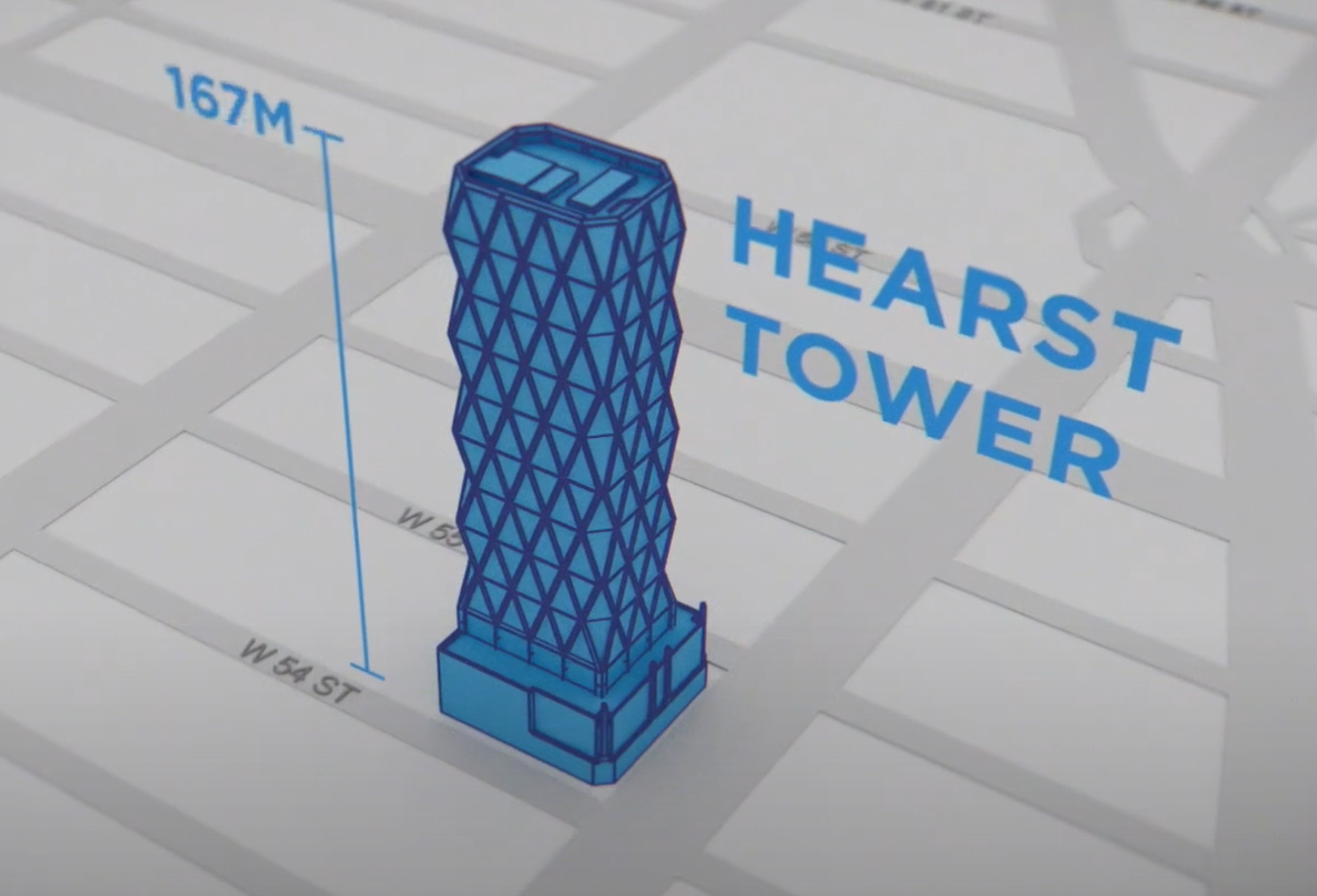
Above: Hearst Tower was modest compared to the giants of the past.
The facade of this building is more than just an eye-catching design. Its diagonal grid pattern in fact comes from its supporting trusses.
But despite that striking effect, the Hearst Tower is something of a forgotten skyscraper in this city, probably most well-known for being the first to emerge here after 9/11. In time the city’s high-rise hiatus began to fade, and engineers and developers started to find themselves in a race for space.
As the 2000s wore on and rolled into the early 2010s the reimagined World Trade Center began to emerge in Lower Manhattan, filling the painful void that had been left in the skyline.
Formed by a potent mix of emotion, politics and compromise, the tallest new skyscraper to rise from the site sought to evoke the silhouette of the former Twin Towers, as if they had merged together.
It reached a symbolic height of 1,776 feet – nodding to the year of American independence, and looked down to a pair of sunken waterfalls on the footprints of the buildings that once stood there; the sound of crashing water drowning out the city and creating a space for reflection. New York was beginning to move on, but it would never forget.
In a way, the rebuilding at ground zero started the turning of a page and gave a kind of gentle permission to the city to start building tall again. The high-rise was back, but for a new age.
The 2020s - The Billionaire Skyscraper
Gone are the domineering office towers, architecture is now an asset. There’s not much space left to build on in Manhattan so as the 2010s progressed, developers started getting even more inventive – constructing skyscrapers over live rail yards and pushing the limits of engineering.
The 1920s may have had jazz and Gatsby, but the 2020s has a new billionaire class. The 1 percent of the 1 percent. Never before has there been so much money for so few – and those people need somewhere to put all that money. This is Billionaires’ Row.
To develop the small sites remaining on 57th Street with buildings tall enough to offer Central Park views and enough floor space to make a return, developers here spent years acquiring the air rights for properties around their lots. That enabled them to combine those rights onto their sites and build their towers taller, helpfully preventing some nearby buildings blocking their views.
And it’s all given rise to this – 111W57; the world’s thinnest skyscraper. Rising 435-metres above the city – but with a width of just 18 metres – the structure offers ultra-luxury apartments and tries to hark back to the past. The classic stepped form has returned, as well as terra-cotta, a material not really seen on towers since the days of Art Deco.
This remarkable, pencil thin structure and its neighbours were all born out of the latest force shaping New York – extreme wealth.
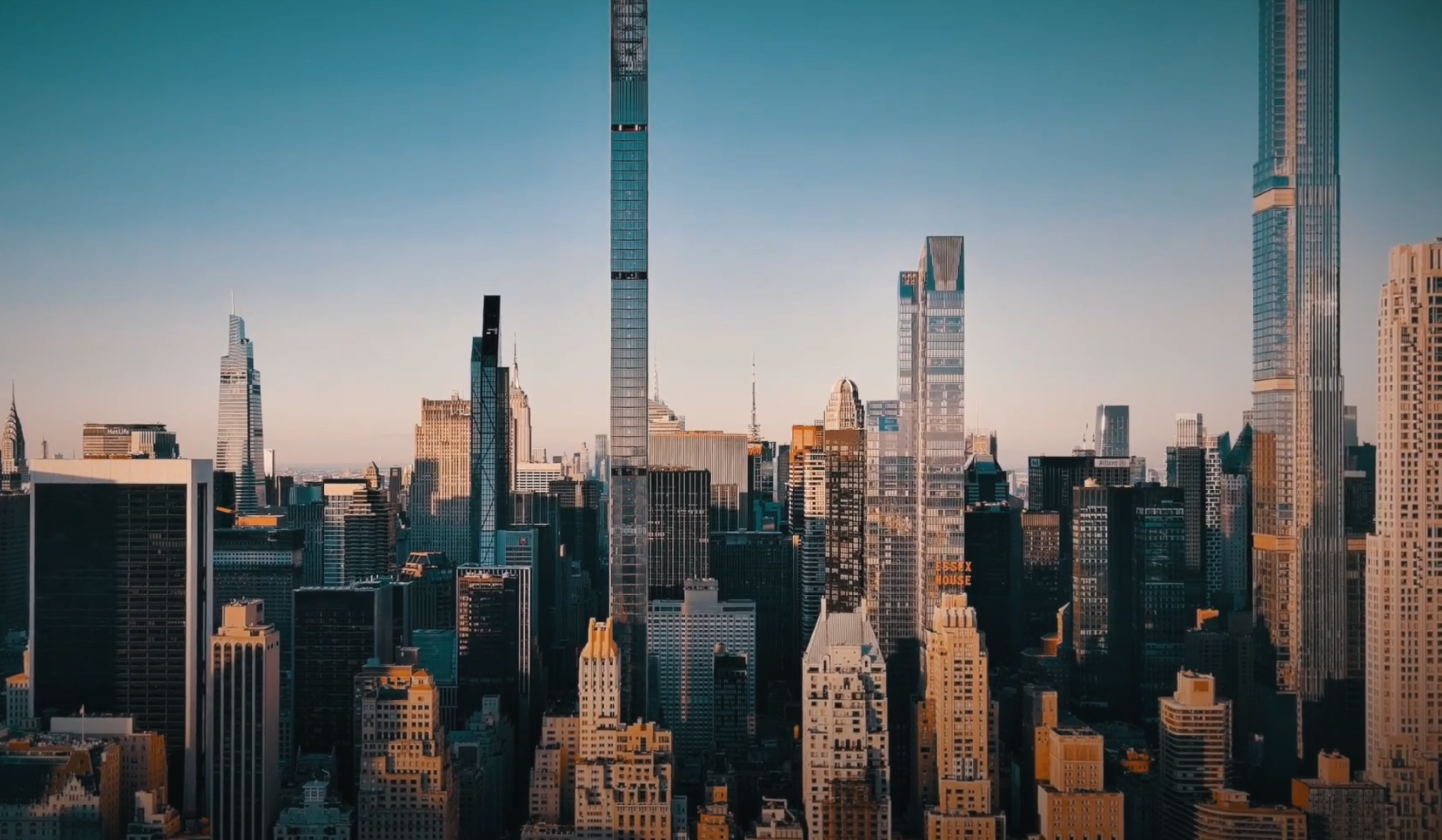
Above: The pencil-thin towers of Billionaire's Row. Image courtesy of The Dronalist.
These buildings are no longer simply property. They are assets. The luxury apartments they offer are less “home” and more “safety deposit box in the sky”. Many are bought and left empty, sometimes deliberately, to retain their value.
Love them or hate them, these super-slender towers now stand as immovable markers of this latest chapter in New York’s history. They rise in a time of growing billionaire backlash and in a world that feels like its changing faster and more unpredictable than ever before.
The Future
The skyscrapers of the 2030s are being planned today – and we’ve got a preview.
Remarkably, we’re about to see a return of the mega office building, much like the Chrysler and Empire State.
New York is set to witness its next skyscraper boom. There are at least four new supertalls being constructed, collectively adding some 11M square feet of new real estate to this island. And it’s all because of one little decision made in 2017: the rezoning of Midtown East.
You see, Midtown East had a problem. It’s one of the highest profile business addresses in the world. There’s over 60M square feet of office space, a quarter million jobs, and numerous Fortune 500 companies – but it’s also extremely old. The average age of its buildings goes back more than 70 years.
In response, a dramatic rezoning – or re-writing of the rules – was approved by the City Council enabling far greater and denser office buildings. In exchange for that greater density, developers would have to contribute to a new “District Improvement Fund” to create a transit and pedestrian network. Part of that is due to improve the subway in and around Grand Central Terminal.
Now we know what you’re thinking, and many of the skyscrapers coming up out of this rezoning were in fact designed before 2020 and therefore meant for a very different world.
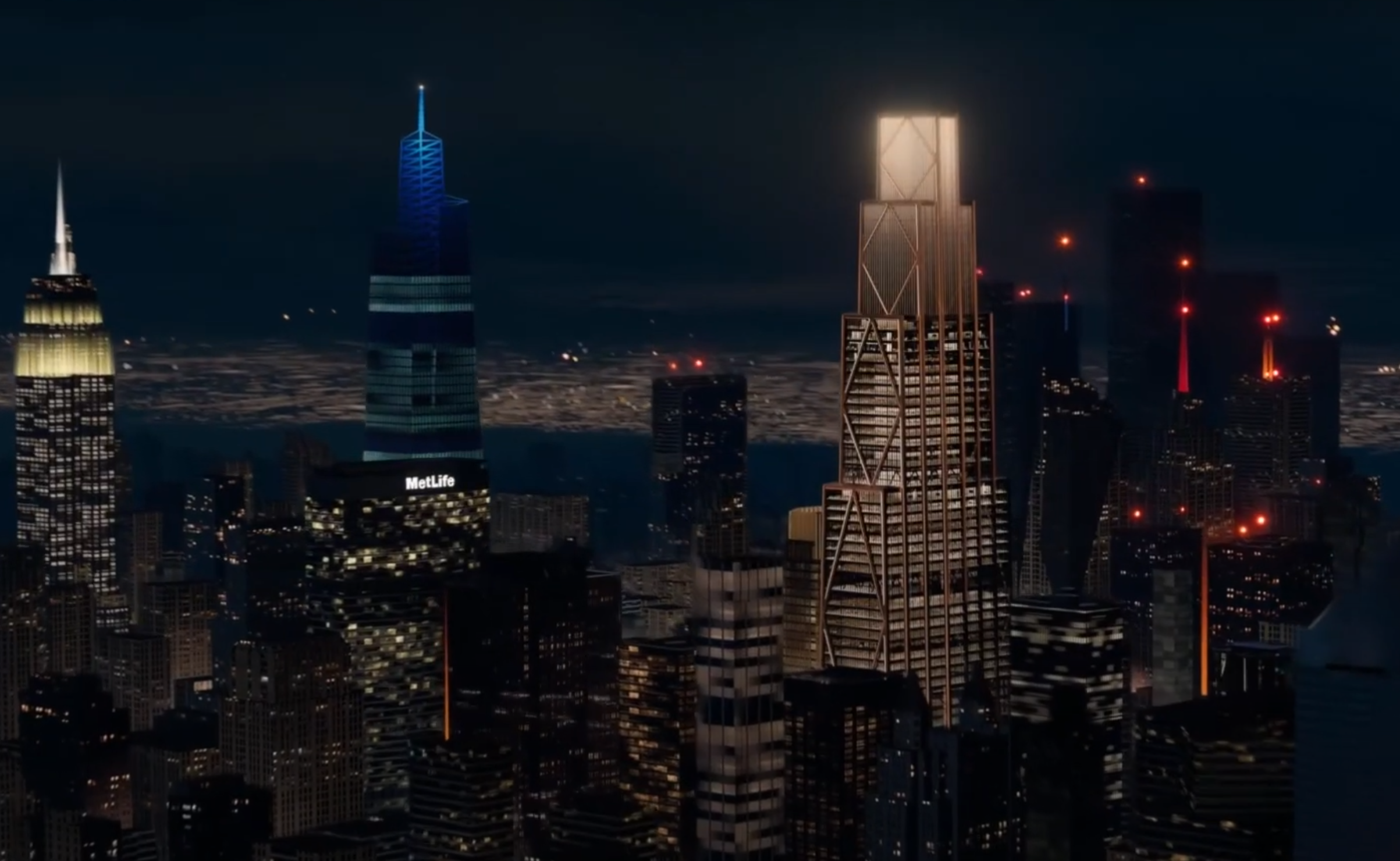
Above: New York's future office buildings will dominate the skyline. Image courtesy of Foster + Partners.
With a pandemic, rise in remote working and a looming recession, the last couple of years haven’t exactly paved the way for a great office tower comeback – but that’s kind of reminiscent of the birth of the Empire State Building, which found itself adding hundreds of thousands of square feet of commercial real estate into Manhattan during the Great Depression.
270 Park Avenue is one of the first new skyscrapers to enjoy the benefits of greater density. The 423-metre supertall is designed like a series of dominos. Just a bit taller than the Twin Towers were in 1973, the building returns to the iconic stepped form of classic New York skyscrapers, a move that makes its dominating presence a little easier to take.
But 175 Park Avenue – or Project Commodore as it’s also known – doesn’t pull back from making an impact.
This immense skyscrape will rise just across the road from the Chrysler Building, and at 480-metres will completely block-out the New York icon – the famous structure from the start of our story now superseded; consumed by that now relentless race for the skies that it helped start almost a century ago.
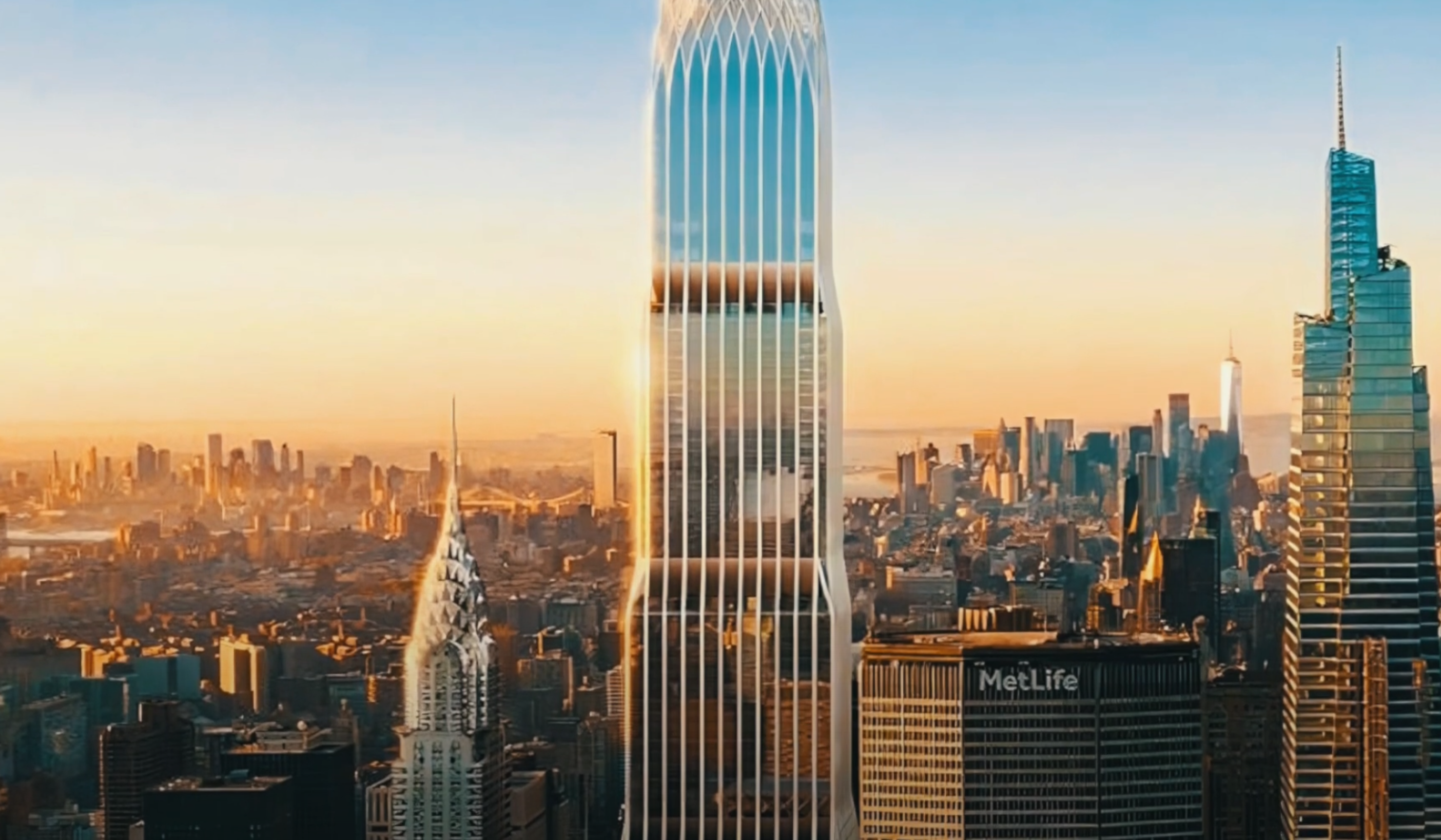
Above: An artist’s impression of 175 Park Avenue. Image courtesy of Ekoo Media / Skidmore, Owings + Merrill.
The Chrysler Building may have only been the world’s tallest for less than a year, it may have been disliked when it first went up – but the Chrysler Building is New York.
It’s bold and brash. It’s a product of fierce competition. It’s an advertisement, a capitalist monument – and a piece of spectacular art. It’s an eyesore and one of the most beautiful structures ever built. What happens when it's covered up?
You can tell a lot about a city and its people by the buildings that dominate its skyline. Whether it's the church steeple, the mega office building, the half empty luxury apartment tower, or a true icon. Each is a monument of its era.
Our buildings tell us something fundamental about who we are and what we prioritise. That’s the case all over the world, but nowhere is it clearer than in New York.
We may dislike new buildings when they first appear, but the fact is the city doesn’t belong to one person, one time or one building. It’s ever changing, ever evolving. That’s how it should be.
New York City will never be finished.
This video contains paid promotion for Bluebeam. Learn more about Bluebeam and iconic NYC buildings here.
Additional footage courtesy of The Dronalist, Paramount Pictures, 20th Century Fox, Balthazar Korab, Jeff Mock, the African American Museum and Library at Oakland, Pat Bianculli, Ted, Quackenbush, Karl Döringer, Grandmaster E, De Laurentiis Entertainment Group, Columbia - EMI - Warner Distributors, Hasbro, Arista, Apple Inc, National Aerobic Championship, Tri-Star Pictures, Jim Hubbard, Fox 5 New York, ABC 7 New York, This Old House / PBS, PIX 11 News, Foster + Partners, Earthcam, SHoP Architects, CNN, Warner Bros / DreamWorks Pictures, Buena Vista International, Warner Bros. Television, Sky News, TODAY, CBS News, Ekoo Media / Skidmore, Owings + Merrill, The New York Public Library and Newsweek.
We welcome you sharing our content to inspire others, but please be nice and play by our rules.








